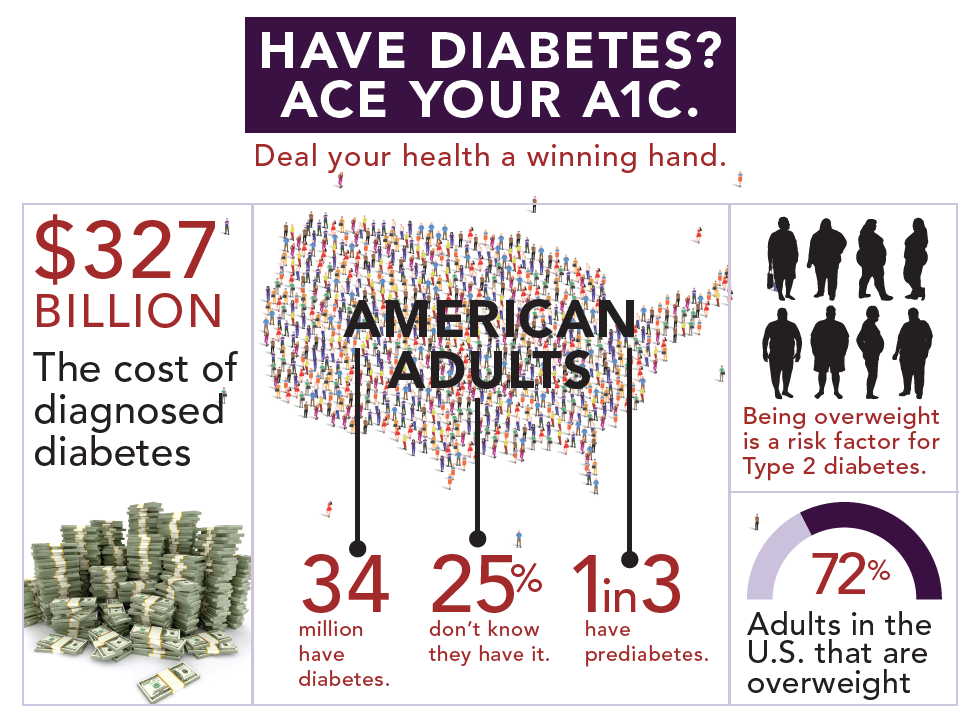Live Well
Ace Your A1C

If you have prediabetes or diabetes, don’t gamble with your health.
It takes more than the luck of the draw to manage prediabetes or diabetes. Give yourself an ace up your sleeve by taking a few smart steps for your health.
About 34 million adults in the United States have diabetes, a chronic condition that affects how your body turns food into energy. Healthy choices can make a big difference in the lives of people who are at risk for diabetes or who already have it.
Prediabetes
More than 1 in 3 American adults have prediabetes. This means they have elevated blood sugar levels and are at risk for developing Type 2 diabetes. They also face a greater risk of heart disease and stroke. According to the Centers for Disease Control and Prevention* (CDC), losing as little as 5 percent of your body weight can reduce your chances of developing Type 2 diabetes. Talk to your doctor about whether you should get a blood test to check for prediabetes.
Watch your A1C
Doctors can use A1C tests to diagnose prediabetes and diabetes. An A1C test shows your average blood sugar levels over the past three months. For people who already have diabetes, their A1C levels will tell their doctors how well they are managing the condition. Higher blood sugar levels indicate an elevated risk of medical complications. That’s why it’s so important to keep track of your A1C levels and work with your doctor to meet your goals.
The CDC recommends adults over age 45 get an A1C baseline test to detect diabetes or prediabetes. They also recommend screening for individuals under 45 who are overweight and have one or more other risk factors for prediabetes or Type 2 diabetes. People who have diabetes should get an A1C test at least twice a year. Talk to your doctor about what works best for you.
Protect your feet
If you have diabetes, pay attention to the health of your feet. Nearly half of all people with diabetes have nerve damage, which usually impacts legs and feet the most. This can cause a loss of feeling in the feet, making it harder to discover problems before they become serious. Also, many people with diabetes have peripheral artery disease (PAD), which reduces blood flow to their feet. These issues combined make foot problems more likely for people with diabetes.
If you have diabetes, the CDC recommends checking your feet daily, using a mirror for the bottom of your feet if necessary. Look for any changes to your feet or signs of injury. Ask your doctor to examine your feet during every health care visit.
Eye exams
Diabetes is the top cause of vision loss in people ages 18 to 64. Regular eye exams can prevent 95 percent of diabetes-related vision loss. Yearly comprehensive dilated eye exams can uncover signs of potential problems. An eye care professional will put drops in your eyes that widen your pupils. This allows his or her to get a better look at the back of your eyes to detect signs of problems.
Stick to your medications
It’s important to take prescribed medications properly. Otherwise, they might not be as effective. This is especially important for people with chronic conditions like diabetes, but researchers estimate people fail to take their medication properly 50 percent of the time. Be sure this doesn’t apply to you. Take your medication at the same time every day. If you make it a part of your regular routine, you’ll be less likely to forget. Talk to your doctor and pharmacist about the prescription medications you are taking. Make them aware of any changes in your health or any problems or questions you have.
Take smart steps to manage your diabetes and stay healthy. Check your A1C levels, keep your feet healthy, get annual eye exams, and take your medications as directed.
*The CDC is an independent organization that offers health information you may find helpful.
*Statistics and information are accurate as of the time of publication and may change over time.
